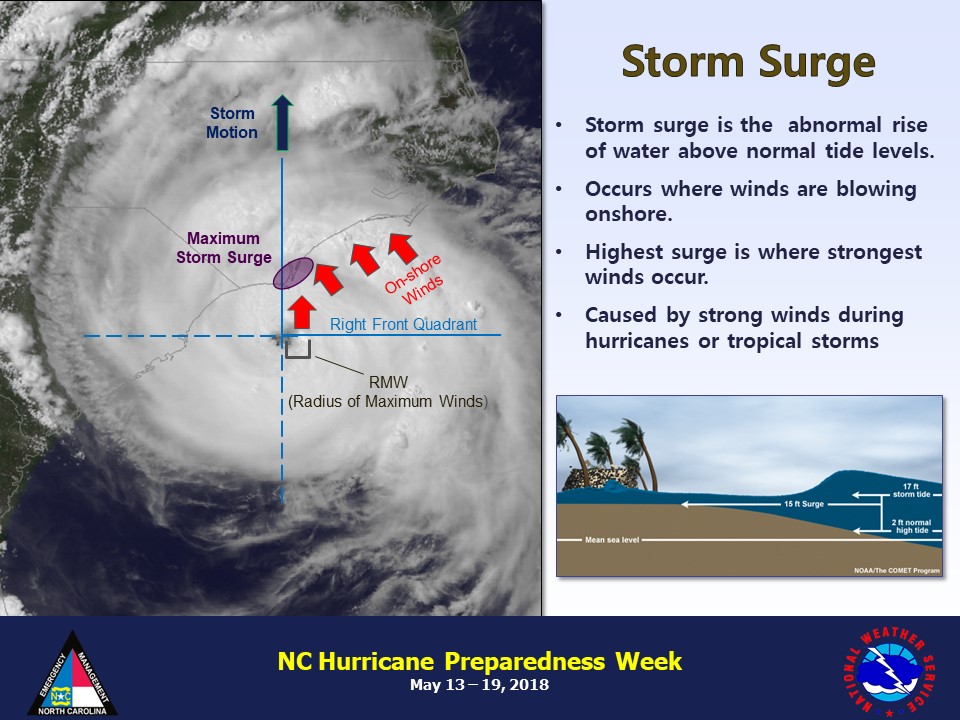This Week is North Carolina’s Hurricane Preparedness Week for 2018
June 1 is the beginning of 2018’s hurricane season for North Carolina, but preparation starts now. Last year was one of the most active hurricane seasons on record in the US, producing six major hurricanes and two of the three costliest hurricanes in US history. UNC-Chapel Hill recognizes the importance of hurricane preparedness, recalling the campus impact from Hurricane Fran in 1996.
The Office of Emergency Management & Planning encourages each student, faculty, and staff member to read the hurricane preparedness information on the National Weather Service in Raleigh website. The key to effective preparedness is knowing your local risks, developing a plan of action, and having a means of staying informed. Take advantage of our campus safety resources, registering for Alert Carolina, downloading the LiveSafe mobile app, and following the general safety tips, all accessible on our CarolinaSafe website.
The time to prepare is now!
All week long the National Weather Service will issue informative messages to help you prepare for the hurricane season. Today’s topics include storm surge and developing an evacuation plan.
One of the greatest potentials for loss of life related to a hurricane is from the storm surge. Storm surge is simply water that is pushed toward the shore by the force of the winds swirling around the storm. This advancing surge combines with the normal tides to create the hurricane storm tide, which can increase the mean water level to heights impacting roads, homes and other critical infrastructure. In addition, wind driven waves are superimposed on the storm tide. This rise in water level can cause severe flooding in coastal areas, particularly when the storm tide coincides with the normal high tides. Because much of the United States’ densely populated Atlantic and Gulf Coast coastlines lie less than 10 feet above mean sea level, the danger from storm tides is tremendous.
The storm surge combined with wave action can cause extensive damage, severely erode beaches and coastal highways. With major storms like Katrina, Camille and Hugo, complete devastation of coastal communities occurred. Many buildings withstand hurricane force winds until their foundations, undermined by erosion, are weakened and fail. Storm surge can travel several miles inland and can also span hundreds of miles of coastline.
It is important to keep in mind that storm surge is not a factor in the Saffir-Simpson Hurricane Scale. Know that even a tropical storm or Category 1 hurricane can have a devastating storm surge if the proper conditions exist. In other words, don’t assume that a tropical storm or a hurricane on the low end of the Saffir-Simpson Scale will not have a large or significant storm surge. Be sure to stay informed and pay close attention to storm surge forecast details regardless of the Saffir-Simpson Hurricane Scale rating.

The first thing you need to do is find out if you live in a storm surge hurricane evacuation zone or if you’re in a home that would be unsafe during a hurricane. If you are, figure out where you’d go and how you’d get there if told to evacuate. You do not need to travel hundreds of miles. Identify someone, perhaps a friend or relative who doesn’t live in a zone or unsafe home, and work it out with them to use their home as your evacuation destination. If you don’t live in an evacuation zone, identify someone who does, and plan to be their inland evacuation destination. Be sure to account for your pets, as most local shelters do not permit them. Finally, be sure to put the plan in writing for you and those you care about.
For more information about hurricane preparedness, please visit the following websites:

